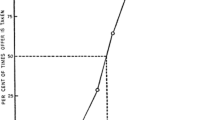Abstract
This paper examines the cross-fertilizations of random utility models with the study of decision making under risk and uncertainty. We start with a description of the expected utility (EU) theory and then consider deviations from the standard EU frameworks, involving the Allais paradox and the Ellsberg paradox, inter alia. We then discuss how the resulting non-EU framework can be modeled and estimated within the framework of discrete choices in static and dynamic contexts. Our objectives in addressing risk and ambiguity in individual choice contexts are to understand the decision choice process and to use behavioral information for prediction, prescription, and policy analysis.


Similar content being viewed by others
References
Ackerberg, D., Benkard, L., Berry, S., & Pakes, A. (2007). Econometric tools for analyzing market outcomes. In J. J. Heckman, & E. Leamer (Eds.), Handbook of econometrics(vol. 6). Amsterdam: Elsevier.
Avineri, E., & Prashker, J. N. (2005). Sensitivity to travel time variability: Travelers’ learning perspective. Transportation Research Part C: Emerging Technologies, 13(2), 157–183.
Benitez-Silva, H., & Dwyer, D. (2005). The rationality of retirement expectations and the role of new information. Review of Economics and Statistics, 87, 587–592.
Brownstone, D., & Small, K. A. (2005). Valuing time and reliability: Assessing the evidence from road pricing demonstrations. Transportation Research A, 39, 279–293.
Chamberlain, G. (1984). Panel data. In Z. Griliches, & M. Intriligator (Eds.), Handbook of econometrics (vol. 2, (pp. 1247–1318)). Amsterdam: Elsevier.
Chateauneuf, A., Eichberger, J., & Grant, S. (2007). Choice under uncertainty with the best and worst in mind: Neo-additive capacities. Journal of Economic Theory, 137(1), 538–567.
Conte, A., Hey, J. D., & Moffatt, P. G. (2008). Mixture models of choice under risk. Journal of Econometrics, in press.
de Palma, A., & Picard, N. (2006). Equilibria and information provision in risky networks with risk averse drivers. Transportation Science, 40(4), 393–408.
de Palma, A., & Picard, N. (2005). Route choice decision under travel time uncertainty. Transportation Research Part A, 39(4), 295–324.
Dubé, J. P., Chintagunta, P. K., Petrin, A., Bronnenberg, B., Goettler, R., Seetharaman, P. B., et al. (2002). Structural applications of the discrete choice model. Marketing Letters, 13, 207–220.
Dubé, J. P., Sudhir, K., Ching, A., Crawford, G. S., Draganska, M., Fox, J. T., et al. (2005). Recent advances in structural econometric modeling: Dynamics, product positioning and entry. Marketing Letters, 16, 209–224.
Gajdos, T, Tallon, J.-M., & Vergnaud, J. C. (2008). Representation and aggregation of preferences under uncertainty. Journal of Economic Theory, doi:10.1016/j.jet.2007.10.001.
Gilboa, I., & Schmeidler, D. (1989). Maxmin expected utility with a non-unique prior. Journal of Mathematical Economics, 18, 141-153.
Grether, D. M., & Plott, C. R. (1979). Economic theory of choice and the preference reversal phenomenon. American Economic Review, 69, 623–638.
Heckman, J. J., & Navarro, S. (2007). Dynamic discrete choice and dynamic treatment effects. Journal of Econometrics, 136, 341–396.
Hey, J. D., & Orme, C. D. (1994). Investigating generalisations of expected utility theory using experimental data. Econometrica, 62, 1291–1326.
Holt, C. A. (2006). Markets, games, and strategic behavior. Boston: Addison-Wesley.
Holt, C. A., & Laury, S. K. (2002). Risk aversion and incentive effects. American Economic Review, 92(5), 1644–1655.
Kahneman, D., & Tversky, A. (1979). Prospect theory: An analysis of decision under risk. Econometrica, 47, 263-291.
Lam, T. C., & Small, K. A. (2001). The value of time and reliability: Measurement from a value pricing experiment. Transportation Research E, 37, 231–251.
Loomes, G., Moffatt, P. G., & Sugden, R. (2002). A microeconometric test of alternative stochastic theories of risky choice. Journal of Risk and Uncertainty, 24, 103–130.
Machina, M. J. (1989). Dynamic consistency and non-expected utility models of choice under uncertainty. Journal of Economic Literature, 27, 1622-1688.
Magnac, T., & Thesmar, D. (2002). Identifying dynamic discrete choice processes. Econometrica, 70, 801–816.
Manski, C. F. (2004). Measuring expectations. Econometrica, 72, 1329–1376.
McFadden, D. (1981). Chapter 5: Econometric models of probabilistic choices. In C. F. Manski, & D. McFadden (Eds.), Structural analysis of discrete data with economic applications (pp. 198–272). Chicago: University of Chicago Press.
McFadden, D. (2001). Economic choices. Nobel lecture, December 2000. American Economic Review, 91(3), 351–378.
Prelec, D. (1998). The probability weighting function. Econometrica, 66, 497–527.
Quiggin, J. (1982). A theory of anticipated utility. Journal of Economic Behavior and Organization, 3, 323-343.
Rust, J. (1994). Structural estimation of Markov decision processes. In R. Engle, & D. McFadden (Eds.), Handbook of econometrics (vol. 4, (pp. 3081–3143)). Amsterdam: Elsevier.
Schmeidler, D. (1989). Subjective probability and expected utility without additivity. Econometrica, 57, 571-587.
Small, K. (1987). A discrete choice model for ordered alternatives. Econometrica, 55(2), 409–424.
Train, K. (2003). Discrete choice methods with simulation. New York: Cambridge University Press.
Tversky, A., & Kahneman, D. (1992). Advances in prospect theory: cumulative representation of uncertainty. Journal of Risk and Uncertainty, 5(4), 297–323.
Van Soest, A., Kapteyn, A., & Zissimopoulos, J. (2007). Using stated preferences data to analyze preferences for full and partial retirement. IZA working paper 2785, Bonn.
Vissing-Jorgensen, A., & Attanasio, O. P. (2005). Stock-market participation, intertemporal substitution, and risk-aversion. American Economic Review, 93, 383–391.
Acknowledgment
We benefited from the advice and comments of Mohammed Abdellaoui and Robin Lindsey, and from the editorial assistance of Leanne Russell. Eric Bradlow’s and Robert Meyer’s suggestions were very helpful for improving the first draft of the paper. Finally, André de Palma and Nathalie Picard would like to thank RiskAttitude, ANR (FR) program, for supporting financially the June 2007 meeting.
Author information
Authors and Affiliations
Corresponding author
Rights and permissions
About this article
Cite this article
de Palma, A., Ben-Akiva, M., Brownstone, D. et al. Risk, uncertainty and discrete choice models. Mark Lett 19, 269–285 (2008). https://doi.org/10.1007/s11002-008-9047-0
Received:
Accepted:
Published:
Issue Date:
DOI: https://doi.org/10.1007/s11002-008-9047-0




